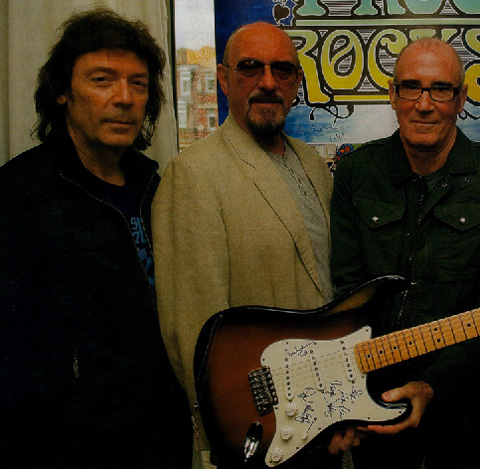Outside of the tight and supremely precise circle of progressive rock, Gentle Giant is an anomaly, a riddle wrapped in the unknown, an enigma treading water in a sea of pretentiousness. Yeah, they’re that cool. In 2005, eight mid-70s albums from Gentle Giant were remastered and reissued as “35th Anniversary” editions on Alucard Music, owned and operated by Gentle Giant keyboardist Kerry Minnear, and DRT Entertainment, partly owned and operated by Gentle Giant singer Derek Shulman. After the band broke up in 1980, Shulman went on to become a top record executive, signing groups like Bon Jovi and Dream Theater, then becoming president of both ATCO and Roadrunner Records. He knew how to market and package music.
Of course, Gentle Giant isn’t exactly a mainstream act, and they weren’t expecting to sell millions of records, especially in this day and age. But the reissues proved the band had an ample body of work worthy of re-examination by dedicated proggers in all the corners of the earth. To promote the reissues, I was given the opportunity to interview both Derek Shulman and his brother Ray, who played bass and violin, and wrote most of the music for Gentle Giant with keyboardist Kerry Minnear. After Gentle Giant, Ray became a music producer, and worked with numerous acts including the Sugarcubes, Björk’s first group.
Today, Ray Shulman works in computer graphics, and, as it turns out, a new Gentle Giant 5.1 mix was released in the summer of 2014. Teaming with 5.1 guru Steven Wilson, with whom he has collaborated on previous DVD and Blu-ray Disc projects, Ray was on hand to give a Blu-ray Disc 5.1 mix of Gentle Giant’s 1974 release The Power And The Glory. And once again, to help promote the set’s release, I interviewed Ray Shulman, even though, as you’ll learn, I hadn’t actually heard the 5.1 mix. I finally broke down and bought it, and I have to say Steven Wilson and Ray Shulman have injected new life into The Power & The Glory. The surround mix is really something to hear, with an enhanced optical perspective that still leaves much to the imagination. Here’s what else Ray Shulman had to say about working on this project, his role in Gentle Giant, and his current work with Steven Wilson.
~
Hi Ray, how are you today?
Not too bad at all. How are you doing?
Great. And it’s great to talk to you again. Of course, tonight we’re talking about the reissue, The Power And The Glory.
That’s right.
I haven’t heard the surround sound mix yet, but I’ve heard Steven Wilson’s work and I’m looking forward to hearing this mix because I’ve heard his stuff with King Crimson, ELP and Yes. He’s obviously the go-to guy for prog in surround.
Yes, he is. I know. He’s very good. The surround mix — I think it sounds great, the surround mix. I look forward to you hearing it.
Have you heard his other mixes with some of these other bands?
Oh, yeah, yeah. I’ve known Steven for quite a while. My day job nowadays is kind of making DVDs and Blu-rays for other kind of people. When Stephen does a Blu-ray and a DVD, I kind of put those together for him. So we’ve known each other a while.
That’s right. Because you do visual work, which you did on this Blu-ray, I understand.
That’s right. That’s part of what I do.
I’m interested to learn a little more about that. But first of all, how did this idea of doing a remaster for Gentle Giant come up? Did Steven Wilson bring it up or did you bring it up?
He brought it up. In fact, over the years, we’ve been out and other people have said, “Can I do a surround mix of your music?” and all that kind of thing. We just go, “Oh yes. Sure, no problem.” But I’ve never taken them up. I’ve been working with Steven for a while, and then I found out he was really kind of a massive Gentle Giant fan. Him and both his manager are huge Gentle Giant fans. And he said, “Look, I’d love to get involved and do a remix of your album.” So we said, “Well, OK.” And then, “What do you want the first one to be?” We haven’t been very good in archiving our original master tapes. For some reason, some have been lost forever. But I know we have all The Power And The Glory tapes together and it’s one of those things we thought, “Well, it’s a good album to start with, the band played really well on it,” So we said, “OK, we’ll do that one.” And then as I got more involved, more into the video side. Essentially, it’s like Steven’s saying, “I really want to get involved with Gentle Giant. I’d love to do a remix of your album.” So that’s how it started.
I was rather surprised — I guess aside from the fact that it’s its 40th anniversary — that you chose that particular title and not, say, something like Octopus or Free Hand, which was probably your most successful record.
We’re probably going to do another one next year next year, and we’re aiming to do Octopus. To do Octopus, there’s still two of the multitracks we can’t find. So that’s the reason we didn’t go with it this time. It’s just one of those things. We should probably put it out there if anybody knows where our tapes are kind of thing.
So there are plans to do more Gentle Giant titles in surround?
In surround? Yeah, definitely.
Tell me a little about the visuals that you did on this Blu-ray. I mean, are these like abstract images or the band or the video? You’re syncing the music up with the video, I would imagine.
Yes, absolutely. I’ve used the lyrics as part of the graphics. It’s essentially, we knew we were going to do a surround mix, I thought, well, we want to present it to people — essentially to people who bought it before and even new people who come to this music — in the very best audio you can get. At the moment, the best audio file you can put out is on Blu-ray, so we put the 96/24 stereo on there and kind of uncompressed surround sound on the Blu-ray, and on the DVD, just a slight little bit less on that one. So as that was the main carrier for this mix, we thought, well, it really gives us an opportunity to do something.
Part of my day job is doing graphics for the DVDs and all that kind of stuff, so I said, “I’ll have a go at doing one.” So the first one I thought would be easy enough would be — not easy enough, but to start — I did “Cogs In Cogs” and I did it very graphically and used a lot of things because I know the timing better than other people. It’s not an interpretation of the lyrics because that would be too hard, and everybody has their own interpretation of things like lyrics and that’s really Derek’s domain, as he wrote the lyrics. It’s more an interpretation of the music in a kind of visual way, and then using the lyrics and everything else in quite a graphic way really.
I sent a demo to Kerry and Derek and they loved it. They said, “Well, OK, that’s great. Can you carry on?” I said, “OK, I’ll try and carry on.” Really, in my spare time, I went back to each track even as Steven was starting to mix them. I just kept on going and eventually, after a couple of months, I had something for each track. As I say, it’s not as I say an interpretation of the lyrics. It’s more of an interpretation of the music. And also, hey, because it’s on Blu-ray and DVD, it’s really something to put on the screen. People can look at it or they don’t have to look at it. That’s the way I feel about it.
Looking back at the making of The Power And The Glory, you co-wrote a lot of these songs. When you’re going through this and you’re putting the visuals together and everything, does it bring back memories about making the record? Were you thinking visually at all when you were putting this music together?
I think we always thought visually anyway, not just in the nature, I forget who it was, but it was one kind of critic, I think he said it was “cinematic rock” or something like that. Perhaps that’s a bit too pompous to say. But we always thought in the visual stuff. That was the days before any kind of visual, no video or anything really. We all thought in terms of stories, really telling a story. The nature of our music, it kind of works in sections in terms of any way, any little episode. It went on its own little journey, really.
The very nature of progressive rock lends itself to visual media.
Yeah.
Speaking of progressive rock, or in the parlance of our times, “prog rock,” I think you could agree that it’s attained an esteemed air of historical significance and its influence is often cited by newer musicians. Certainly, many have cited the influence of Gentle Giant. What’s your take on all of this?
It’s nice to be when you hear about that kind of thing, it’s amazing. You think, “Wow.” My brother with record company stuff. And he found out that Questlove is a huge fan of Gentle Giant. And they’re great musicians in their own right. You can’t believe it, really. It’s a good feeling. It really is.
I’ll bet. On the remaster, you’ve included a bonus track called “The Power And The Glory,” which was not on the original album.
No, it wasn’t. It was really an afterthought. It was more influenced by the record company saying, “Well, we need a single.” If I remember rightly, after the album was out, I think we went in and recorded three different songs to come up with a single. I know we lost the other two, but I think “The Power and the Glory” was an attempt to do a kind of single based on really the only thing relevant about it was the lyric. I think we didn’t like it for a lot of years, but now lots of time has kind of mellowed us, and I think it’s OK.
I can see where that would be potentially a single for the band, not that you guys were making singles at all, but that definitely had all the ingredients. In the press release I received, it had all of the band members chipping in with a quote here and there, so I guess you’re all talking to one another.
We’ve kept in touch, even though there’s no possibility of a reunion or anything. Kerry lives a way away, but we see each other quite regularly. We keep in touch. I’m always interested in his family and stuff, because he’s always just been a friend, as well as everything else.
Do you still play?
Only for my own amusement. I’ve had a few careers since the band, always to do with music and in studios. But nowadays it’s more for my own interest than anything else.
I know you did some producing, and you worked with Björk and The Sugarcubes, but now you’re pretty much into graphics?
I think it was throughout the late 80s and into the 90s, I was spending so much time away from home and in a studio — and you know, the studio just eats up your life. It’s like, you either have a life, or if you want a home life you don’t work in a studio. I got into graphics because I was always interested in computers anyway, and that made it possible. And it means I can work from home in my kind of home studio. I get to edit music and, for my own amusement, I get out the guitars occasionally.
You were saying you worked on other Blu-rays. Have you done stuff with Porcupine Tree and other bands we might know?
I’ve done all the Steven Wilson Blu-rays that he has out, on his solo stuff.
I have those.
Oh you have those? The Raven and all that kind of thing?
Yes, I’m a big fan of Steve Wilson. I met him last year and I saw him play. His stuff is brilliant.
It’s great. He’s a great musician as well.
So you did all the visuals on his Blu-rays?
Not necessarily all of them, because sometimes he uses this German illustrator. I put them all together.
I see. Is there anything else out there that we might see your work on?
I’ve done so many. I’ve done a lot of stuff with Jethro Tull.
Oh, really?
You know, all that kind of stuff.
A Passion Play?
I did A Passion Play. That’s one of mine, yeah.
The recent one?
The recent one, yeah.
Oh man, that’s fantastic.
That’s a good one, I think, that one. And I did the new Ian Anderson one, Homo Erraticus.
We reviewed that one on VintageRock.com. That’s awesome. Now I’m really looking forward to seeing and hearing The Power And The Glory in surround.
Absolutely. It comes alive.





















